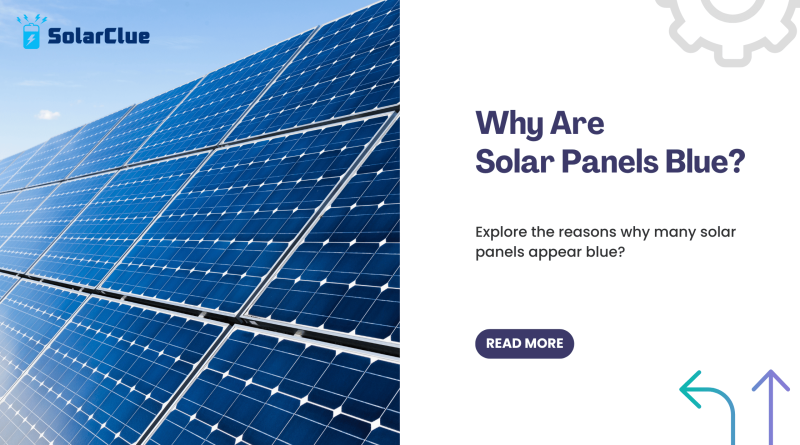Why Are Solar Panels Blue?
Have you ever noticed that many solar panels have a distinct blue hue? This characteristic color often leads to curiosity and questions about the science behind it. This blog post explores the reasons why many solar panels appear blue, focusing on the role of polycrystalline silicon, anti-reflective coatings, and the differences between polycrystalline and monocrystalline panels.
Table of Contents
- 1 The Science Behind the Blue Color of Solar Panels
- 1.1 Polycrystalline Silicon and Its Role in Panel Appearance
- 1.2 Anti-Reflective Coatings and Their Impact on Color
- 1.3 Comparison of Blue and Black Solar Panels
- 1.4 The Influence of Color on Solar Panel Efficiency
- 1.5 The Future of Solar Panel Aesthetics and Color Options
- 1.6 Common Misconceptions About the Color of Solar Panels
- 1.7 The Role of Color in Solar Panel Marketing and Branding
- 1.8 FAQs
The Science Behind the Blue Color of Solar Panels
Solar panels are designed to capture sunlight and convert it into electricity. The color of solar panels is a result of the materials used in their manufacturing and the specific treatments applied to enhance their efficiency. Two main factors contribute to the blue appearance of many solar panels: the type of silicon used and the anti-reflective coatings applied to the surface.
Polycrystalline Silicon and Its Role in Panel Appearance
What is Polycrystalline Silicon?
Polycrystalline silicon, also known as multicrystalline silicon, is a type of silicon used in the manufacturing of solar cells. It is made by melting raw silicon and pouring it into a mold to cool and solidify. The resulting silicon is composed of many small silicon crystals, giving it a distinctive appearance.
How Polycrystalline Silicon Affects Color
The manufacturing process of polycrystalline silicon results in a grainy, speckled structure. This structure scatters light differently compared to monocrystalline silicon, which is made from a single crystal. The light-scattering properties of polycrystalline silicon give the panels a bluish tint. Additionally, the presence of certain additives and impurities during the manufacturing process can enhance the blue color.
Anti-Reflective Coatings and Their Impact on Color
Purpose of Anti-Reflective Coatings
Anti-reflective coatings are applied to solar panels to reduce the reflection of sunlight and increase the amount of light absorbed by the solar cells. These coatings are crucial for improving the efficiency of solar panels, as more absorbed light translates to more electricity generated.
How Coatings Influence Color
The anti-reflective coatings commonly used on polycrystalline solar panels are designed to enhance light absorption by minimizing reflections. These coatings often have a blue or purple hue due to their specific chemical composition and the way they interact with light. When applied to the already blue-tinted polycrystalline silicon, these coatings intensify the blue appearance of the panels.
Comparison of Blue and Black Solar Panels
Monocrystalline Solar Panels
Monocrystalline solar panels are made from a single, continuous crystal structure. This manufacturing process results in a uniform black appearance. The black color is due to the high purity of the silicon and the anti-reflective coatings used, which are optimized for maximum light absorption without affecting the color.
Polycrystalline vs. Monocrystalline
- Color: Polycrystalline panels appear blue, while monocrystalline panels are black.
- Efficiency: Monocrystalline panels are generally more efficient due to their higher silicon purity and uniform structure.
- Cost: Polycrystalline panels are typically less expensive to produce, making them a more affordable option for many consumers.
- Aesthetics: The color difference can influence consumer preference based on the visual integration with their property.
The Influence of Color on Solar Panel Efficiency
While color itself does not directly impact efficiency, the materials and coatings that determine the color play a significant role. Anti-reflective coatings are essential for enhancing light absorption, and the specific formulations used can affect the overall efficiency of the panels. Monocrystalline panels, despite being black, often have higher efficiencies due to the uniformity and purity of their silicon.
The Future of Solar Panel Aesthetics and Color Options
Advancements in solar technology are paving the way for more diverse aesthetic options. Researchers are exploring new materials and coatings that can offer a broader range of colors without compromising efficiency. This could lead to solar panels that better blend with architectural designs and personal preferences.
Common Misconceptions About the Color of Solar Panels
Color Indicates Quality: The color of a solar panel is not a direct indicator of its quality or efficiency. Both blue and black panels have their advantages and applications.
Blue Panels are Less Efficient: While monocrystalline panels are generally more efficient, polycrystalline panels are still highly effective and suitable for many installations.
Color Affects Performance: The performance of solar panels is more influenced by their material quality, manufacturing process, and coatings than by their color.
The Role of Color in Solar Panel Marketing and Branding
Solar panel manufacturers often use color and design as part of their branding strategy. The color can influence consumer perceptions and preferences, making aesthetics an important consideration in the marketing of solar products. As the market grows, offering a variety of color options could become a competitive advantage.
Conclusion
The blue color of many solar panels is primarily due to the use of polycrystalline silicon and anti-reflective coatings. While the color itself does not directly impact the efficiency, the materials and processes that create the color are crucial for the panel’s performance. Understanding these factors helps consumers make informed decisions when choosing solar panels. As technology advances, we can expect more options in solar panel aesthetics, enhancing their integration into diverse environments.
Here at SolarClue®, we offer a smart, practical, and “beautiful” solution. You will be answered for all the questions related to Solar.
We provide all kinds of brands that are the Best Solar panels in India.
If you are the one who is planning for the solar power system. Don’t hesitate to contact our team!
Looking forward to empowering you with solar energy, just like hundreds of our other clients!
FAQs
1. Why do many solar panels appear blue?
Many solar panels appear blue due to the use of polycrystalline silicon and anti-reflective coatings that enhance light absorption.
2. What is the difference between polycrystalline and monocrystalline solar panels?
Polycrystalline panels are blue and made from multiple silicon crystals, while monocrystalline panels are black and made from a single silicon crystal, offering higher efficiency.
3. Does the color of a solar panel affect its efficiency?
The color itself does not affect efficiency, but the materials and coatings that determine the color play a crucial role in the panel’s performance.
4. Are black solar panels better than blue ones?
Black monocrystalline panels are generally more efficient, but blue polycrystalline panels are more affordable and still highly effective for many applications.
5. Will solar panels be available in more colors in the future?
Advances in technology are likely to offer more color options for solar panels, allowing for better integration with architectural designs and personal preferences.


